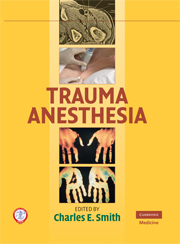Book contents
- Frontmatter
- Contents
- Foreword
- Foreword
- Preface
- Acknowledgments
- Contributors
- 1 Mechanisms and Demographics in Trauma
- 2 Trauma Airway Management
- 3 Shock Management
- 4 Establishing Vascular Access in the Trauma Patient
- 5 Monitoring the Trauma Patient
- 6 Fluid and Blood Therapy in Trauma
- 7 Massive Transfusion Protocols in Trauma Care
- 8 Blood Loss: Does It Change My Intravenous Anesthetic?
- 9 Pharmacology of Neuromuscular Blocking Agents and Their Reversal in Trauma Patients
- 10 Anesthesia Considerations for Abdominal Trauma
- 11 Head Trauma – Anesthesia Considerations and Management
- 12 Intensive Care Unit Management of Pediatric Brain Injury
- 13 Surgical Considerations for Spinal Cord Trauma
- 14 Anesthesia for Spinal Cord Trauma
- 15 Musculoskeletal Trauma
- 16 Anesthetic Considerations for Orthopedic Trauma
- 17 Cardiac and Great Vessel Trauma
- 18 Anesthesia Considerations for Cardiothoracic Trauma
- 19 Intraoperative One-Lung Ventilation for Trauma Anesthesia
- 20 Burn Injuries (Critical Care in Severe Burn Injury)
- 21 Anesthesia for Burns
- 22 Field Anesthesia and Military Injury
- 23 Eye Trauma and Anesthesia
- 24 Pediatric Trauma and Anesthesia
- 25 Trauma in the Elderly
- 26 Trauma in Pregnancy
- 27 Oral and Maxillofacial Trauma
- 28 Damage Control in Severe Trauma
- 29 Hypothermia in Trauma
- 30 ITACCS Management of Mechanical Ventilation in Critically Injured Patients
- 31 Trauma and Regional Anesthesia
- 32 Ultrasound Procedures in Trauma
- 33 Use of Echocardiography and Ultrasound in Trauma
- 34 Pharmacologic Management of Acute Pain in Trauma
- 35 Posttrauma Chronic Pain
- 36 Trauma Systems, Triage, and Transfer
- 37 Teams, Team Training, and the Role of Simulation in Trauma Training and Management
- Index
- Plate section
- References
19 - Intraoperative One-Lung Ventilation for Trauma Anesthesia
Published online by Cambridge University Press: 18 January 2010
- Frontmatter
- Contents
- Foreword
- Foreword
- Preface
- Acknowledgments
- Contributors
- 1 Mechanisms and Demographics in Trauma
- 2 Trauma Airway Management
- 3 Shock Management
- 4 Establishing Vascular Access in the Trauma Patient
- 5 Monitoring the Trauma Patient
- 6 Fluid and Blood Therapy in Trauma
- 7 Massive Transfusion Protocols in Trauma Care
- 8 Blood Loss: Does It Change My Intravenous Anesthetic?
- 9 Pharmacology of Neuromuscular Blocking Agents and Their Reversal in Trauma Patients
- 10 Anesthesia Considerations for Abdominal Trauma
- 11 Head Trauma – Anesthesia Considerations and Management
- 12 Intensive Care Unit Management of Pediatric Brain Injury
- 13 Surgical Considerations for Spinal Cord Trauma
- 14 Anesthesia for Spinal Cord Trauma
- 15 Musculoskeletal Trauma
- 16 Anesthetic Considerations for Orthopedic Trauma
- 17 Cardiac and Great Vessel Trauma
- 18 Anesthesia Considerations for Cardiothoracic Trauma
- 19 Intraoperative One-Lung Ventilation for Trauma Anesthesia
- 20 Burn Injuries (Critical Care in Severe Burn Injury)
- 21 Anesthesia for Burns
- 22 Field Anesthesia and Military Injury
- 23 Eye Trauma and Anesthesia
- 24 Pediatric Trauma and Anesthesia
- 25 Trauma in the Elderly
- 26 Trauma in Pregnancy
- 27 Oral and Maxillofacial Trauma
- 28 Damage Control in Severe Trauma
- 29 Hypothermia in Trauma
- 30 ITACCS Management of Mechanical Ventilation in Critically Injured Patients
- 31 Trauma and Regional Anesthesia
- 32 Ultrasound Procedures in Trauma
- 33 Use of Echocardiography and Ultrasound in Trauma
- 34 Pharmacologic Management of Acute Pain in Trauma
- 35 Posttrauma Chronic Pain
- 36 Trauma Systems, Triage, and Transfer
- 37 Teams, Team Training, and the Role of Simulation in Trauma Training and Management
- Index
- Plate section
- References
Summary
Objectives
Review the indications for one-lung ventilation in trauma.
Describe the physiologic effects of one-lung ventilation in trauma.
Review the modern management of one-lung ventilation, including treatment for intraoperative hypoxemia.
Discuss lung isolation techniques and relevant bronchial anatomy.
Discuss the advantages and disadvantages of equipment options for achieving lung isolation.
INTRODUCTION
Trauma patients that have thoracic injuries are extremely difficult to manage and require great expertise with careful clinical management [1]. Other major injuries may be present and management is made much more difficult by the urgency of the situation. The traditional classification of blunt versus penetrating thoracic trauma is important and both mechanisms can lead to significant respiratory injury, at any level within the tracheobronchial tree [2]. Nevertheless, all trauma algorithms place the utmost emphasis on establishing a safe airway. In thoracic trauma, this airway often means having the ability to establish one-lung ventilation (OLV).
LUNG ISOLATION IN TRAUMA PATIENTS
Traditionally, the approach to lung isolation has been divided into absolute and relative indications (Table 19.1) [3]. Within this table, there are two guiding principles that encompass all the indications for OLV. These two categories are:
Lung Protection: To prevent contralateral lung soiling against blood or secretions (pus), or to prevent further lung injury secondary to positive pressure ventilation, as in the case of a bronchopleural fistula or severe pulmonary contusion.
Surgical Procedures: To facilitate surgical resection. In the case of video-assisted thoracoscopic surgery, it is essential.
Both approaches can help guide the clinician, but the decision to establish OLV should be made on a case-by-case basis.
- Type
- Chapter
- Information
- Trauma Anesthesia , pp. 300 - 313Publisher: Cambridge University PressPrint publication year: 2008



